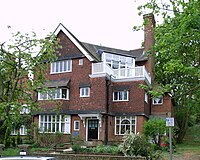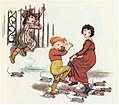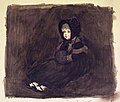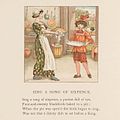Kate Greenaway: Difference between revisions
→Life and career: rem; will replace |
References can't be left out. Proposed lead too long and POV. Please look at similar pages for guidance. |
||
| Line 18: | Line 18: | ||
}} |
}} |
||
'''Catherine Greenaway''' (17 March 1846{{spaced ndash}}6 November 1901) was |
'''Catherine Greenaway''' (17 March 1846{{spaced ndash}}6 November 1901) was an English [[children's book]] illustrator<ref>{{cite magazine|title=Greenaway, Kate|magazine= Who's who biographies, 1901|page=496|url=https://books.google.com/books?id=8EcuAAAAYAAJ&pg=PA496}}</ref> and writer. Her drawings gave rise to a fashion in young children's clothing in the 1880s and 1890s. |
||
==Life and career== |
==Life and career== |
||
[[File:Under the Window.jpg|thumb|left|upright=0.85|Title page of ''[[Under the Window]]'' (1879)]] |
|||
Greenaway spent much of her childhood at [[Rolleston, Nottinghamshire]]. She studied at what is now the [[Royal College of Art]] in London, in the section for women. (The college was then headed by [[Richard Burchett]].) Her first book, ''[[Under the Window]]'' (1879), a collection of simple, perfectly [[idyll]]ic verses about children, was a bestseller. |
Greenaway spent much of her childhood at [[Rolleston, Nottinghamshire]].<ref>''The Nottinghamshire Village Book'' (Newbury: Countryside Books, 1989), p. 136.</ref> She studied at what is now the [[Royal College of Art]] in London, in the section for women. (The college was then headed by [[Richard Burchett]].) Her first book, ''[[Under the Window]]'' (1879), a collection of simple, perfectly [[idyll]]ic verses about children, was a bestseller. |
||
| ⚫ | Greenaway's paintings were reproduced by [[chromoxylography]], by which the colours were printed from hand-engraved wood blocks by the firm of [[Edmund Evans]]. Through the 1880s and 1890s, her only rivals in popularity in children's [[book illustration]] were [[Walter Crane]] and [[Randolph Caldecott]]. |
||
As well as illustrating books Greenaway produced a number of [[bookplates]].<ref>Clark, Keith. ''The Bookplate Designs of Kate Greenaway'', in ''The Private Library'' Autumn 1975, published by the [[Private Libraries Association]]</ref> |
As well as illustrating books Greenaway produced a number of [[bookplates]].<ref>Clark, Keith. ''The Bookplate Designs of Kate Greenaway'', in ''The Private Library'' Autumn 1975, published by the [[Private Libraries Association]]</ref> |
||
| ⚫ | "Kate Greenaway" children, all of them girls and boys too young to be put in trousers, were dressed in her own versions of [[1795–1820 in fashion|late 18th century and Regency fashions]]: [[smock-frock]]s and [[skeleton suit]]s for boys, high-waisted pinafores and dresses with [[Bonnet (headgear)|mobcaps and straw bonnet]]s for girls. The influence of children's clothes in portraits by British painter [[John Hoppner]] (1758–1810) may have provided her some inspiration. [[Liberty (department store)|Liberty of London]] adapted Kate Greenaway's drawings as designs for actual children's clothes. A full generation of mothers in the liberal-minded "artistic" British circles who called themselves [[The Souls]] and embraced the [[Arts and Crafts movement]] dressed their daughters in Kate Greenaway pantaloons and bonnets in the 1880s and 1890s. The style was often used by painter [[Maude Goodman]] in her depictions of children. |
||
[[File:39 Frognal.jpg|thumb|upright=0.9|The house in [[Frognal]] built for Kate Greenaway by [[Richard Norman Shaw]]]] |
[[File:39 Frognal.jpg|thumb|upright=0.9|The house in [[Frognal]] built for Kate Greenaway by [[Richard Norman Shaw]]]] |
||
Greenaway was elected to membership of the [[Royal Institute of Painters in Water Colours]] in 1889. She lived in an Arts and Crafts style house she commissioned from [[Richard Norman Shaw]] in [[Frognal]], London, although she spent summers in Rolleston. |
Greenaway was elected to membership of the [[Royal Institute of Painters in Water Colours]] in 1889. She lived in an Arts and Crafts style house she commissioned from [[Richard Norman Shaw]] in [[Frognal]], London, although she spent summers in Rolleston. |
||
Greenaway died of breast cancer in 1901, at the age of 55. She is buried in [[Hampstead Cemetery]], London. The [[Kate Greenaway Medal]], established in her honour in 1955, is awarded annually by the [[Chartered Institute of Library and Information Professionals]] in the UK to an illustrator of children's books. |
Greenaway died of breast cancer in 1901, at the age of 55. She is buried in [[Hampstead Cemetery]], London. The [[Kate Greenaway Medal]], established in her honour in 1955, is awarded annually by the [[Chartered Institute of Library and Information Professionals]] in the UK to an illustrator of children's books. |
||
| ⚫ | Greenaway's paintings were reproduced by [[chromoxylography]], by which the colours were printed from hand-engraved wood blocks by the firm of [[Edmund Evans]]. Through the 1880s and 1890s, her only rivals in popularity in children's [[book illustration]] were [[Walter Crane]] and [[Randolph Caldecott]]. |
||
| ⚫ | "Kate Greenaway" children, all of them girls and boys too young to be put in trousers, were dressed in her own versions of [[1795–1820 in fashion|late 18th century and Regency fashions]]: [[smock-frock]]s and [[skeleton suit]]s for boys, high-waisted pinafores and dresses with [[Bonnet (headgear)|mobcaps and straw bonnet]]s for girls. The influence of children's clothes in portraits by British painter [[John Hoppner]] (1758–1810) may have provided her some inspiration. [[Liberty (department store)|Liberty of London]] adapted Kate Greenaway's drawings as designs for actual children's clothes. A full generation of mothers in the liberal-minded "artistic" British circles who called themselves [[The Souls]] and embraced the [[Arts and Crafts movement]] dressed their daughters in Kate Greenaway pantaloons and bonnets in the 1880s and 1890s. The style was often used by painter [[Maude Goodman]] in her depictions of children. |
||
==Books illustrated== |
==Books illustrated== |
||
| Line 127: | Line 126: | ||
*{{wikisource author-inline}} |
*{{wikisource author-inline}} |
||
*{{Gutenberg author |id=Greenaway,+Kate | name=Kate Greenaway}} |
*{{Gutenberg author |id=Greenaway,+Kate | name=Kate Greenaway}} |
||
*{{FadedPage|id=Greenaway, Kate (Catherine)|name=Kate Greenaway (illustrator)|author=yes}} |
|||
*{{Internet Archive author |sname=Kate Greenaway}} |
*{{Internet Archive author |sname=Kate Greenaway}} |
||
*{{Librivox author |id=1377}} |
|||
*[http://ufdc.ufl.edu/juv/results/?t=,,kate+greenaway,&f=ZZ,+TI,+AU,+TO Kate Greenaway's books], full-text searchable with all images from the [http://ufdc.ufl.edu/juv Baldwin Library of Historical Children's Literature Digital Collection] at the [[University of Florida]] Libraries |
*[http://ufdc.ufl.edu/juv/results/?t=,,kate+greenaway,&f=ZZ,+TI,+AU,+TO Kate Greenaway's books], full-text searchable with all images from the [http://ufdc.ufl.edu/juv Baldwin Library of Historical Children's Literature Digital Collection] at the [[University of Florida]] Libraries |
||
*[http://cdm16028.contentdm.oclc.org/cdm/compoundobject/collection/p15324coll10/id/92353 Pierre Bonnard, the Graphic Art], an exhibition catalogue from The Metropolitan Museum of Art (fully available online as PDF), which contains material on Greenaway (see index) |
|||
*[http://hdl.loc.gov/loc.rbc/bit.11404 ''A Apple Pie''] From the Collections at the [[Library of Congress]] |
|||
*[http://hdl.loc.gov/loc.rbc/gen.32708 ''Little Ann and Other Poems''] From the Collections at the [[Library of Congress]] |
|||
*[http://hdl.loc.gov/loc.rbc/juv.27626 ''The Pied Piper of Hamlin''] From the Collections at the [[Library of Congress]] |
|||
*{{LCAuth|n79145163|Kate Greenaway|84|ue}} |
*{{LCAuth|n79145163|Kate Greenaway|84|ue}} |
||
Revision as of 21:29, 17 September 2017
Kate Greenaway | |
|---|---|
 | |
| Born | Catherine Greenaway 17 March 1846 |
| Died | 6 November 1901 (aged 55) |
| Nationality | English |
| Education | Heatherley School of Fine Art |
| Known for | Creation of picture books |
Catherine Greenaway (17 March 1846 – 6 November 1901) was an English children's book illustrator[1] and writer. Her drawings gave rise to a fashion in young children's clothing in the 1880s and 1890s.
Life and career

Greenaway spent much of her childhood at Rolleston, Nottinghamshire.[2] She studied at what is now the Royal College of Art in London, in the section for women. (The college was then headed by Richard Burchett.) Her first book, Under the Window (1879), a collection of simple, perfectly idyllic verses about children, was a bestseller.
Greenaway's paintings were reproduced by chromoxylography, by which the colours were printed from hand-engraved wood blocks by the firm of Edmund Evans. Through the 1880s and 1890s, her only rivals in popularity in children's book illustration were Walter Crane and Randolph Caldecott.
As well as illustrating books Greenaway produced a number of bookplates.[3]
"Kate Greenaway" children, all of them girls and boys too young to be put in trousers, were dressed in her own versions of late 18th century and Regency fashions: smock-frocks and skeleton suits for boys, high-waisted pinafores and dresses with mobcaps and straw bonnets for girls. The influence of children's clothes in portraits by British painter John Hoppner (1758–1810) may have provided her some inspiration. Liberty of London adapted Kate Greenaway's drawings as designs for actual children's clothes. A full generation of mothers in the liberal-minded "artistic" British circles who called themselves The Souls and embraced the Arts and Crafts movement dressed their daughters in Kate Greenaway pantaloons and bonnets in the 1880s and 1890s. The style was often used by painter Maude Goodman in her depictions of children.

Greenaway was elected to membership of the Royal Institute of Painters in Water Colours in 1889. She lived in an Arts and Crafts style house she commissioned from Richard Norman Shaw in Frognal, London, although she spent summers in Rolleston.
Greenaway died of breast cancer in 1901, at the age of 55. She is buried in Hampstead Cemetery, London. The Kate Greenaway Medal, established in her honour in 1955, is awarded annually by the Chartered Institute of Library and Information Professionals in the UK to an illustrator of children's books.
Books illustrated
- Kingston, William, Infant Amusements, or How to Make a Nursery Happy, 1867.
- Aulnoy, Marie, Madame D'Aulnoy's Fairy Tales, 9 v., Gall and Inglis, 1871.
- Aunt Louisa's London Toy Books: Diamonds and Toads, Warne, 1871.
- Jeune, Margaret S., My School Days in Paris, London, Griffith and Farran, 1871.
- Knox, Kathleen, Fairy Gifts; or, A Wallet of Wonders, Griffith & Farran, 1874.
- Aunt Cae, The Children of the Parsonage, Griffith & Farran, 1874.
- Mulholland, Rosa, Puck and Blossom, Marcus Ward, 1874.
- Hill, Miranda, The Fairy Spinner, Marcus Ward, 1874.
- Jerrold, Alice, A Cruise in the Acorn, London, Marcus Ward, 1875.
- Clark, Mary Senior, Turnaside Cottage, London, Marcus Ward, 1875.
- Potter, Frederick Scarlett, Melcomb Manor: A Family Chronicle, London, Marcus Ward, 1875.
- Children’s Songs, London, Marcus Ward, c. 1875.
- Knox, Kathleen, Seven Birthdays; or, The Children of Fortune, Griffith & Farran, 1875.
- 'Quiver of Love, a Collection of Valentines' (with Walter Crane), Marcus Ward, 1876.
- LaBlanche, Fanny, Starlight Stories Told to Bright Eyes and Listening Ears, Griffith & Farran, 1877.
- Russell, Rutherford, Tom Seven Years Old, London, Marcus Ward, 1877.
- Hunt, Mrs. Bonavia, Poor Nelly, London, Cassell, Petter, Gilpin, 1878.
- Campbell, Lady Colin, Topo: A Tale About English Children in Italy, Marcus Ward, 1878.
- Yonge, Charlotte Mary, Heartsease; or The Brother’s Wife, Macmillan, 1879.
- Yonge, Charlotte Mary, The Heir of Redclyffe, Macmillan, 1879.
- Pollock, Walter Herries, Amateur Theatricals, London, Macmillan, 1879.
- Toyland, Trot’s Journey and Other Poems and Stories, New York, R. Worthington, c. 1879
- Weatherly, George, The “Little Folks” Painting Book, Cassell, Petter, Gilpin, 1879.
- Weatherly, George, The “Little Folks” Nature Painting Book, Cassell, Petter, Gilpin 1879.
- A Favorite Album of Fun and Fancy, London, Cassell, Petter, Gilpin, c. 1879.
- Haile, Ellen, Three Brown Boys and Other Happy Children, New York, Cassell & Co., c. 1879.
- Haile, Ellen, The Two Gray Girls and Their Opposite Neighbours, New York, Cassell & Co., c. 1879.
- Under the Window, London, George Routledge, 1879. Engraved and colour printed by Edmund Evans.
- Barker, Mrs. Sale, Kate Greenaway's Birthday Book, London, George Routledge, 1880. Engraved and colour printed by Edmund Evans.
- Freddie’s Letter: Stories For Little People, London, Routledge, 1880.
- The Old Farm Gate, London, George Routledge, c. 1880.
- Lang, Andrew, The Library, London, Macmillan and Company, 1881.
- Locker, Frederick, London Lyrics, London, Macmillan and Company, 1881.
- Mother Goose; or, The Old Nursery Rhymes, London, Routledge, 1881. Engraved and colour printed by Edmund Evans.
- Foster, Myles Burkett, A Day in a Child’s Life, London, Routledge, 1882. Engraved and colour printed by Edmund Evans.
- Ranking, Montgomerie and Tully, Thomas K., Flowers and Fancies; Valentines Ancient and Modern, Marcus Ward, 1882.
- Weatherly, F. E., The Illustrated Children’s Birthday Book (with others), London, W. Mack, 1882.
- Taylor, Ann and Jane, Little Ann and Other Poems, London, Routledge, 1883. Engraved and colour printed by Edmund Evans.
- Zimmern, Helen, Tales from the Edda, London, Sonnenschein, 1883.
- Language of Flowers, London, Routledge, 1884. Engraved and colour printed by Edmund Evans.
- A Painting Book By Kate Greenaway, London, George Routledge, 1884. Engraved and colour printed by Edmund Evans.
- Ellice, Robert, compiler, Songs for the Nursery: A Collection of Children’s Poems, Old and New, W. Mack, 1884.
- Kate Greenaway’s Christmas Carols, London: George Routledge, c. 1884.
- Kate Greenaway's Alphabet, London, Routledge, 1885. Engraved and colour printed by Edmund Evans.
- Kate Greenaway's Album, London, Routledge, c. 1885. Engraved and colour printed by Edmund Evans. (only eight copies were printed)
- Marigold Garden: Pictures and Rhymes, London, Routledge, 1885. Engraved and colour printed by Edmund Evans.
- Mavor, William, English Spelling Book, London, Routledge, 1885. Engraved and colour printed by Edmund Evans.
- Ruskin, John, editor, 'Dame Wiggins of Lee and Her Seven Wonderful Cats, London, George Allen, 1885.
- A Apple Pie: An Old-Fashioned Alphabet Book, London, Routledge, 1886. Engraved and colour printed by Edmund Evans.
- Harte, Bret, The Queen of the Pirate Isle, Chatto & Windus, 1886. Engraved and colour printed by Edmund Evans.
- Baby’s Birthday Book, London, Marcus Ward, 1886.
- Allingham, William, Rhymes for the Young Folk, Cassell and Co., 1887. Engraved and colour printed by Edmund Evans.
- Queen Victoria’s Jubilee Garland, London, George Routledge, 1887. Engraved and colour printed by Edmund Evans.
- Browning, Robert, The Pied Piper of Hamelin, London, Routledge, 1888. Engraved and colour printed by Edmund Evans.
- Around the House, New York, Worthington, 1888.
- Kate Greenaway’s Book of Games, London, Routledge, 1889. Engraved and colour printed by Edmund Evans.
- Cresswell, Beatrice F., The Royal Progress of King Pepito, London, Society for Promoting Christian Knowledge, 1889. Engraved and colour printed by Edmund Evans.
- Arnim, Mary Annette, The April Baby’s Book of Tunes, London and New York, Macmillan, 1900. The first use of colour-lithography on any of Kate’s Books.
- Spielmann, Mabel H., Littledom Castle and Other Tales (with others), London, George Routledge, 1903.
- Dobson, Austin, De Libris Prose and Verse (with others), London, Macmillan, 1908, 1911.
- Almanack, London, Routledge,1883–1895. Engraved and colour printed by Edmund Evans.
Gallery
-
Marigold Garden
-
Polly from The Queen of the Pirate Isle, by Bret Harte
-
Rats of Hamelin
-
Greenaway's illustration of the Pied Piper leading the children out of Hamelin, to Robert Browning's version of the tale. Engraving by Edmund Evans.
-
May Day
-
The Elf Ring
-
A Little Girl in a Muff
-
A apple pie: An Old-Fashioned Alphabet Book
-
April Baby's Book of Tunes (1900), by Elizabeth von Arnim
References
- ^ "Greenaway, Kate". Who's who biographies, 1901. p. 496.
- ^ The Nottinghamshire Village Book (Newbury: Countryside Books, 1989), p. 136.
- ^ Clark, Keith. The Bookplate Designs of Kate Greenaway, in The Private Library Autumn 1975, published by the Private Libraries Association
Sources and further reading
- Robert W. Kiger (ed.), Kate Greenaway: Catalogue of an Exhibition of Original Artworks and Related Materials Selected from the Frances Hooper Collection at the Hunt Institute, 1980: ISBN 0-913196-33-9
- Ina Taylor, The Art of Kate Greenaway: A Nostalgic Portrait of Childhood London, 1991: ISBN 0-88289-867-1
- Thomas E. Schuster and Rodney K. Engen, Printed Kate Greenaway: A Catalogue Raisonné, 1986: ISBN 0-9511752-0-3
External links
 Works by or about Kate Greenaway at Wikisource
Works by or about Kate Greenaway at Wikisource- Works by Kate Greenaway at Project Gutenberg
- Works by Kate Greenaway (illustrator) at Faded Page (Canada)
- Works by or about Kate Greenaway at Internet Archive
- Works by Kate Greenaway at LibriVox (public domain audiobooks)

- Kate Greenaway's books, full-text searchable with all images from the Baldwin Library of Historical Children's Literature Digital Collection at the University of Florida Libraries
- Pierre Bonnard, the Graphic Art, an exhibition catalogue from The Metropolitan Museum of Art (fully available online as PDF), which contains material on Greenaway (see index)
- A Apple Pie From the Collections at the Library of Congress
- Little Ann and Other Poems From the Collections at the Library of Congress
- The Pied Piper of Hamlin From the Collections at the Library of Congress
- Kate Greenaway at Library of Congress, with 84 library catalogue records
- 1846 births
- 1901 deaths
- British illustrators
- British children's book illustrators
- British children's writers
- Deaths from breast cancer
- 19th-century illustrators of fairy tales
- People from Hoxton
- Deaths from cancer in England
- English watercolourists
- Alumni of the Royal College of Art
- British women painters
- Burials at Hampstead Cemetery
- 19th-century English painters
- 19th-century women artists
- Women watercolorists









